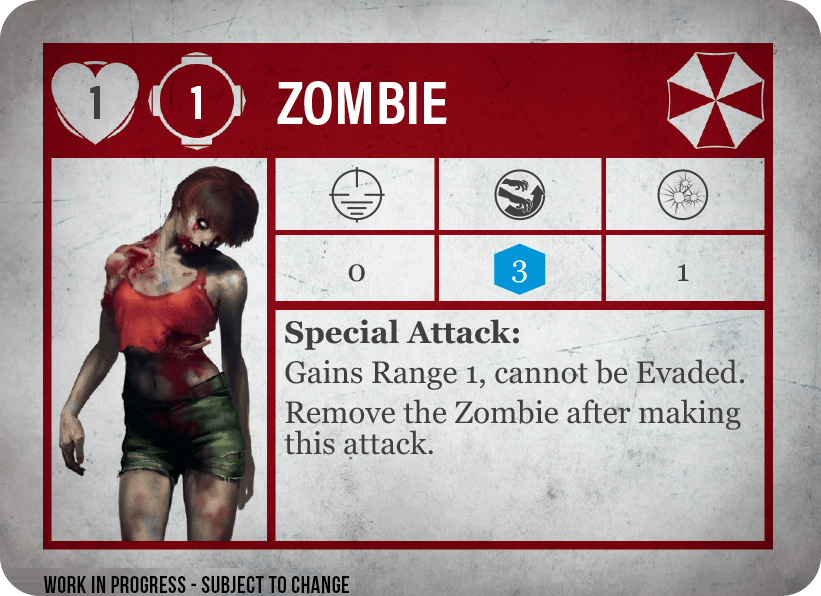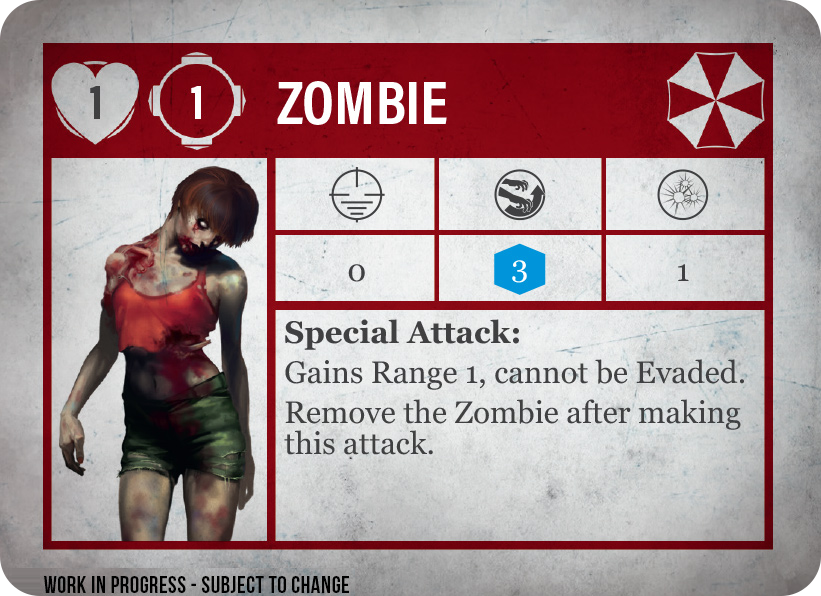Enemies | Resident Evil 2: The Board Game

2020 Update: This post was published during or shortly after the Kickstarter campaign on July 30, 2018, and may contain out-of-date assets and mechanics. To see the final version, check out Resident Evil 2: The Board Game
Knowing your enemy is always important, and this has never been more true than in the streets of Raccoon City. Last week we looked at some of the weapons which our characters were able to find, and discussed the destructive power available to them – if you missed that, you can find it here. In today’s article however, we’re going to look at one of the enemies that players will encounter, and discuss whether it’s always a good idea to open fire at them…
The Zombie

When we first started creating the Resident Evil™ 2: Board Game, we really wanted to find a way to make every enemy count. Each time a player encounters an enemy, no matter what they are, we wanted to force players to have to make decisions about how to deal with them. The result is that even the most basic enemies convey a sense of threat to characters, and are capable of ruining the best laid plans.
The Zombie might be the first enemy the players will encounter but definitely encapsulates this. In the original RE2 video game, Zombies were slow, relatively weak, and didn’t inflict a lot of damage if they managed to get their hands (or teeth) on a character – and in the Resident Evil™ 2: Board Game, the zombie is very similar. Looking at the profile we can see that Zombies are Movement 1, can only sustain 1 Hit Point before they are killed, and only inflict 1 damage if they successfully hit a character. Doesn’t sound too scary, right?
Appearances can be deceptive. Let’s look at the middle stat on the profile which we didn’t mention – the Evade Roll.
When an enemy makes an attack against a character, their player gets to make an Evade Roll, to try and avoid being damaged. If any of the dice come up as a hit, then the character has successfully avoided the attack. Here, we can see that to evade the Zombie’s claws, a player rolls three blue Attack Dice, which offers a reasonable chance of success, but is by no means guaranteed.
We’ve deliberately made Zombies enticingly easy to avoid for two reasons. Firstly, we wanted players to feel able to push their luck and run past them on most occasions. The Zombie is the most basic enemy which players will encounter, and it’s important that this base point felt fair (although you’ll have to forgive us a dark chuckle every time that a player unexpectedly fails an Evade Roll and gets bitten). Secondly, when we look at the Evade Roll, we’re seeing the base Evade Roll for escaping from one Zombie, but what if there are more than one?
If there are multiple enemies that a character needs to evade in the same square, then players must reduce the dice pool by one for each additional enemy. Suddenly that Evade Roll is looking a lot more dangerous, and far less likely to succeed, even with just one additional enemy. Any more than that? Things are starting to look very desperate. And here’s a hint… Zombies usually appear in pairs.
Perhaps now would be time to look in a little more detail at the final rule we haven’t covered from the Zombies profile. Enemy Special attacks are exactly that – a unique and dangerous attack which is triggered out of sequence to how an enemy usually reacts. For the Zombie, this means making a suicide dive, a sudden lunge which latches onto the legs of a character and gives the foul undead easy access to bite away! At least on the plus side, just as in the original video game, the injured character gets to either stomp the Zombies head in, or boot it away down the corridor…
Attacking Makes a LOT of Noise!
So, you may be asking, how does this all relate to knowing when to make attacks, and when to dodge?
In the Resident Evil™ 2: Board Game, players take turns to activate their characters, moving around in search of various items in order to help clear the path before them. Because we wanted the game to be fluid to play and keep players engaged in their struggle for survival throughout, we decided not to give the enemy models their own turn. Instead, as part of their own turn, players have to perform Reactions for nearby enemies, who will have been attracted by the sound of characters running though alleys, searching through shelves, or...
That’s right. Making attacks.
Ironically, although it might eliminate an enemy barring the way forward, making an attack is probably just about the worst thing a player can do when it comes to attracting the attentions of the undead. After all, gunfire and screams tend to make a lot of noise, which will cut through the silence like a claw through skin. Every time you stop to shoot, the undead will lurch closer, and any decision to make an attack in the Resident Evil™ 2: Board Game should be carefully considered. In our last article we mentioned how limited the availability of ammunition was, which is definitely one factor – but now we’ve seen our Zombie friend, perhaps we’re confident we can leave him be, right?
Sure. But Zombies aren’t the only types of enemy models awaiting you. We’re know that you’ll remember this guy, for starters…

Don’t Worry – You Should be Safe Inside Here
Our best advice? Think very carefully, even about a basic enemy like a Zombie. By leaving enemies alone and running past, you save ammunition and don’t attract attention to yourself, but that might well come back to bite you later on. Literally. Of course, you could be lucky, and encounter your foes in a faraway area that you won’t need to return to. After all, Zombies can’t open doors and follow you, right?
Hold that thought. We’ll be back next week to discuss the Tension Deck, and you can make your minds up then…







